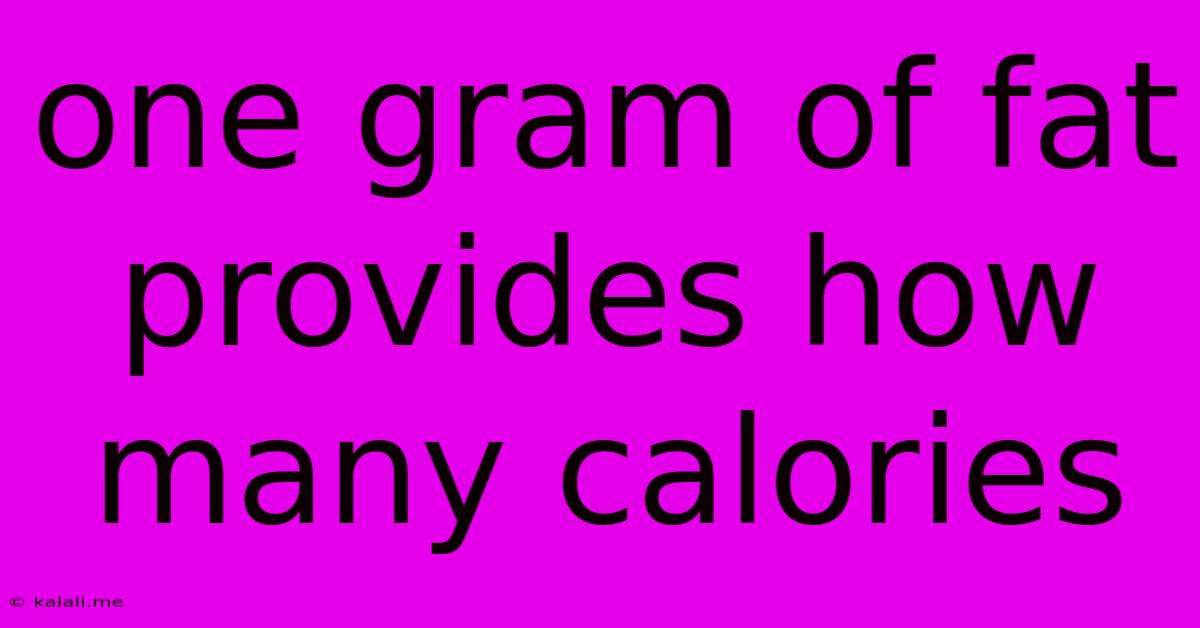One Gram Of Fat Provides How Many Calories
Kalali
Jun 14, 2025 · 3 min read

Table of Contents
One Gram of Fat Provides How Many Calories? A Comprehensive Guide
Meta Description: Wondering how many calories are in a gram of fat? This guide explains the caloric content of fat, its role in your diet, and how to understand nutrition labels effectively. We'll also explore the difference between fat types and their impact on your health.
Understanding the caloric content of different macronutrients is crucial for anyone aiming to manage their weight or improve their overall health. One of the most frequently asked questions revolves around fat: how many calories are in one gram of fat? The answer is a simple yet significant number: nine.
This means that fat provides more than double the calories of carbohydrates and protein, which both contain four calories per gram. This higher caloric density is why fat plays such a crucial role in weight management and overall energy intake.
Why is understanding fat calories important?
Knowing that one gram of fat contains nine calories is fundamental to:
-
Calorie Counting: Accurate calorie counting requires understanding the caloric contribution of each macronutrient. Overconsumption of fat, due to its high calorie density, can easily lead to weight gain if not balanced with appropriate exercise and overall caloric intake.
-
Nutrition Label Reading: Nutrition labels list the total fat content, along with saturated and unsaturated fat breakdowns. Using this information, along with the knowledge that one gram of fat equals nine calories, you can calculate the total calories derived from fat in a particular food item.
-
Dietary Planning: Whether you're following a low-fat diet, a ketogenic diet, or any other dietary plan, understanding the caloric impact of fat is essential for successful meal planning and portion control.
Different Types of Fat: Are they all the same?
Not all fats are created equal. Different types of fat have varying effects on your health and can be categorized as follows:
-
Saturated Fats: Found in animal products (meat, dairy) and some plant-based sources (coconut oil, palm oil). High consumption of saturated fats has been linked to increased cholesterol levels and an elevated risk of heart disease.
-
Unsaturated Fats: These are generally considered healthier fats and are further divided into:
- Monounsaturated Fats: Found in olive oil, avocados, and nuts. They can help lower LDL ("bad") cholesterol.
- Polyunsaturated Fats: Found in vegetable oils (sunflower, corn, soybean), fatty fish (salmon, tuna), and nuts. They include omega-3 and omega-6 fatty acids, essential for various bodily functions.
-
Trans Fats: These are artificially created fats and are generally considered unhealthy. They raise LDL cholesterol and lower HDL ("good") cholesterol, increasing the risk of heart disease. Many countries now have regulations limiting or banning trans fats in processed foods.
Practical Application: Using this information in your diet
Knowing that one gram of fat equals nine calories empowers you to make informed choices about your diet. For instance, a food containing 10 grams of fat will contribute 90 calories (10g x 9 calories/g) solely from fat. This information, when combined with the total calorie count and other macronutrient information on the nutrition label, provides a complete picture of the food's nutritional profile.
By understanding the caloric density of fat and differentiating between fat types, you can make healthier choices that support your weight management goals and overall well-being. Remember to consult a healthcare professional or registered dietitian for personalized dietary advice.
Latest Posts
Latest Posts
-
Which Substance Is A Liquid Fuel Used In Rocket Engines
Jun 15, 2025
-
What Is The Least Common Multiple Of 10 14
Jun 15, 2025
-
Marketing A Service Vs A Product
Jun 15, 2025
-
What Is An Antonym For Artificial
Jun 15, 2025
-
Oxidation State Of V In Vo
Jun 15, 2025
Related Post
Thank you for visiting our website which covers about One Gram Of Fat Provides How Many Calories . We hope the information provided has been useful to you. Feel free to contact us if you have any questions or need further assistance. See you next time and don't miss to bookmark.